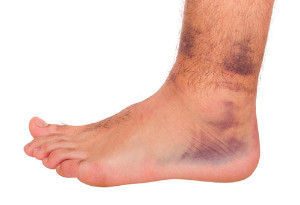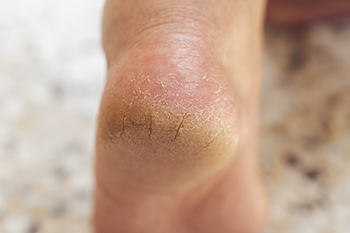Items filtered by date: June 2025
Common Foot and Ankle Injuries for Golfers

Golfers are at risk of developing foot and ankle injuries usually due to the repeated motions involved in swinging the club. One foot issue common to golfers is intermetatarsal neuroma, a painful nerve condition in the forefoot caused by pressure during the swing, often affecting the non-dominant foot. Another problem is lateral ankle pain, which results from repeated motion during follow-through. As the body rotates, the back foot often rolls outward, termed supination, while the heel moves slightly inward. These combined forces can strain the ankle ligaments and surrounding tendons. Golfers may also develop subungual hematomas, which are collections of blood beneath the toenail, typically under the big toe of the dominant foot, caused by repeated pressure during the swing. Even driving the golf cart can lead to top-of-foot pain, especially if the brake is used heavily. A podiatrist can diagnose these issues and recommend effective treatment. If you believe you have foot or ankle pain related to playing golf, it is suggested that you schedule an appointment with a podiatrist, who can offer appropriate relief and treatment solutions.
Sports related foot and ankle injuries require proper treatment before players can go back to their regular routines. For more information, contact one of our podiatrists of Chicago Foot Specialists. Our practitioners can provide the care you need to keep you pain-free and on your feet.
Sports Related Foot and Ankle Injuries
Foot and ankle injuries are a common occurrence when it comes to athletes of any sport. While many athletes dismiss the initial aches and pains, the truth is that ignoring potential foot and ankle injuries can lead to serious problems. As athletes continue to place pressure and strain the area further, a mild injury can turn into something as serious as a rupture and may lead to a permanent disability. There are many factors that contribute to sports related foot and ankle injuries, which include failure to warm up properly, not providing support or wearing bad footwear. Common injuries and conditions athletes face, including:
- Plantar Fasciitis
- Achilles Tendinitis
- Achilles Tendon Rupture
- Ankle Sprains
Sports related injuries are commonly treated using the RICE method. This includes rest, applying ice to the injured area, compression and elevating the ankle. More serious sprains and injuries may require surgery, which could include arthroscopic and reconstructive surgery. Rehabilitation and therapy may also be required in order to get any recovering athlete to become fully functional again. Any unusual aches and pains an athlete sustains must be evaluated by a licensed, reputable medical professional.
If you have any questions please contact our office located in Chicago, IL . We offer the newest diagnostic and treatment technologies for all your foot and ankle needs.
Causes of Ankle Pain While Walking

Ankle pain when walking can result from injuries, overuse, or underlying conditions that affect the foot and ankle structure. Common causes include sprains, which involve stretched or torn ligaments, and fractures, where one or more ankle bones break and may shift out of place. Overuse injuries such as tendonitis, bursitis, and plantar fasciitis often develop gradually and worsen with continued walking. Conditions like arthritis, gout, or posterior tibial tendon dysfunction can also cause ankle pain, stiffness, and reduced mobility. A podiatrist can perform a thorough physical exam, review your medical history, and use diagnostic tools such as X-rays or MRI scans to identify the source of ankle pain. Treatment options include supportive bracing, shoe modifications, and injections. In some cases, surgery may be needed to repair damaged tendons, realign bones, or even replace the ankle joint. If you are experiencing pain while walking, it is suggested that you schedule an appointment with a podiatrist for a diagnosis and appropriate treatment.
Ankle pain can be caused by a number of problems and may be potentially serious. If you have ankle pain, consult with one of our podiatrists from Chicago Foot Specialists. Our practitioners will assess your condition and provide you with quality foot and ankle treatment.
Ankle pain is any condition that causes pain in the ankle. Due to the fact that the ankle consists of tendons, muscles, bones, and ligaments, ankle pain can come from a number of different conditions.
Causes
The most common causes of ankle pain include:
- Types of arthritis (rheumatoid, osteoarthritis, and gout)
- Ankle sprains
- Broken ankles
- Achilles tendonitis
- Achilles tendon rupture
- Stress fractures
- Bursitis
- Tarsal tunnel syndrome
- Plantar fasciitis
Symptoms
Symptoms of ankle injury vary based upon the condition. Pain may include general pain and discomfort, swelling, aching, redness, bruising, burning or stabbing sensations, and/or loss of sensation.
Diagnosis
Due to the wide variety of potential causes of ankle pain, podiatrists will utilize a number of different methods to properly diagnose ankle pain. This can include asking for personal and family medical histories and of any recent injuries. Further diagnosis may include sensation tests, a physical examination, and potentially x-rays or other imaging tests.
Treatment
Just as the range of causes varies widely, so do treatments. Some more common treatments are rest, ice packs, keeping pressure off the foot, orthotics and braces, medication for inflammation and pain, and surgery.
If you have any questions please feel free to contact our office located in Chicago, IL . We offer the newest diagnostic tools and technology to treat your foot and ankle needs.
Causes and Care of Foot Bruises

A foot bruise, also known as a contusion, occurs when small blood vessels break under the skin, leading to discoloration, swelling, and tenderness. It may also appear as a hematoma, where blood pools in a localized area, or purpura, marked by purple patches due to bleeding beneath the skin. Common causes include a sprained ankle, a bone fracture, falling, sports injuries, or dropping a heavy object on the foot. These injuries can damage soft tissue and sometimes affect deeper structures. A podiatrist can evaluate the severity of the bruise, rule out fractures or more serious conditions, and recommend proper care. Foot bruises can often be painful. If you have a bruised foot, it is suggested that you consult a podiatrist who can offer appropriate relief solutions.
Foot Pain
Foot pain can be extremely painful and debilitating. If you have a foot pain, consult with one of our podiatrists from Chicago Foot Specialists. Our practitioners will assess your condition and provide you with quality foot and ankle treatment.
Causes
Foot pain is a very broad condition that could be caused by one or more ailments. The most common include:
- Bunions
- Hammertoes
- Plantar Fasciitis
- Bone Spurs
- Corns
- Tarsal Tunnel Syndrome
- Ingrown Toenails
- Arthritis (such as Gout, Rheumatoid, and Osteoarthritis)
- Flat Feet
- Injury (from stress fractures, broken toe, foot, ankle, Achilles tendon ruptures, and sprains)
- And more
Diagnosis
To figure out the cause of foot pain, podiatrists utilize several different methods. This can range from simple visual inspections and sensation tests to X-rays and MRI scans. Prior medical history, family medical history, and any recent physical traumatic events will all be taken into consideration for a proper diagnosis.
Treatment
Treatment depends upon the cause of the foot pain. Whether it is resting, staying off the foot, or having surgery; podiatrists have a number of treatment options available for foot pain.
If you have any questions, please feel free to contact our office located in Chicago, IL . We offer the newest diagnostic and treatment technologies for all your foot care needs.
Cracked Heels and Podiatry Care

Cracked heels occur when the skin surrounding the heel becomes dry, thickened, and splits due to pressure and lack of moisture. This condition can result from standing for long periods of time, wearing open-back shoes, obesity, or skin conditions such as eczema. In the initial stage, the skin may appear dry and rough. As it progresses, visible cracks form, causing discomfort. In severe cases, the cracks develop into fissures, which can lead to bleeding, pain, and risk of infection. Symptoms may include itching, flaking, and soreness while walking. A podiatrist can evaluate the severity, remove thickened skin safely, recommend moisturizing treatments, and advise on footwear and daily care. If you have cracked heels that are painful, it is strongly suggested that you contact a podiatrist who can offer effective treatment remedies, which often includes prescribed medication.
Cracked heels are unsightly and can cause further damage to your shoes and feet. If you have any concerns, contact one of our podiatrists from Chicago Foot Specialists. Our practitioners can provide the care you need to keep you pain-free and on your feet.
Cracked Heels
Cracked heels appear unappealing and can make it harder for you walk around in sandals. Aside from looking unpleasant, cracked heels can also tear stockings, socks, and wear out your shoes. There are several methods to help restore a cracked heel and prevent further damage.
How Do You Get Them?
Dry skin is the number one culprit in creating cracked heels. Many athletes, walkers, joggers, and even swimmers suffer from cracked heels. Age and skin oil production play a role to getting cracked heels as well.
Promote Healing
Over the counter medicines can help, especially for those that need instant relief or who suffer from chronic dry feet.
Wear Socks – Wearing socks with medicated creams helps lock in moisture.
Moisturizers – Applying both day and night will help alleviate dryness which causes cracking.
Pumice Stones – These exfoliate and remove dead skin, which allows for smoother moisturizer application and better absorption into the skin.
Change in Diet
Eating healthy with a well-balanced diet will give the skin a fresh and radiant look. Your body responds to the kinds of food you ingest. Omega-3 fatty acids and zinc supplements can also revitalize skin tissue.
Most importantly, seek professional help if unsure how to proceed in treating cracked heels. A podiatrist will help you with any questions or information needed.
If you have any questions, please feel free to contact our office located in Chicago, IL . We offer the newest diagnostic and treatment technologies for all your foot care needs.

